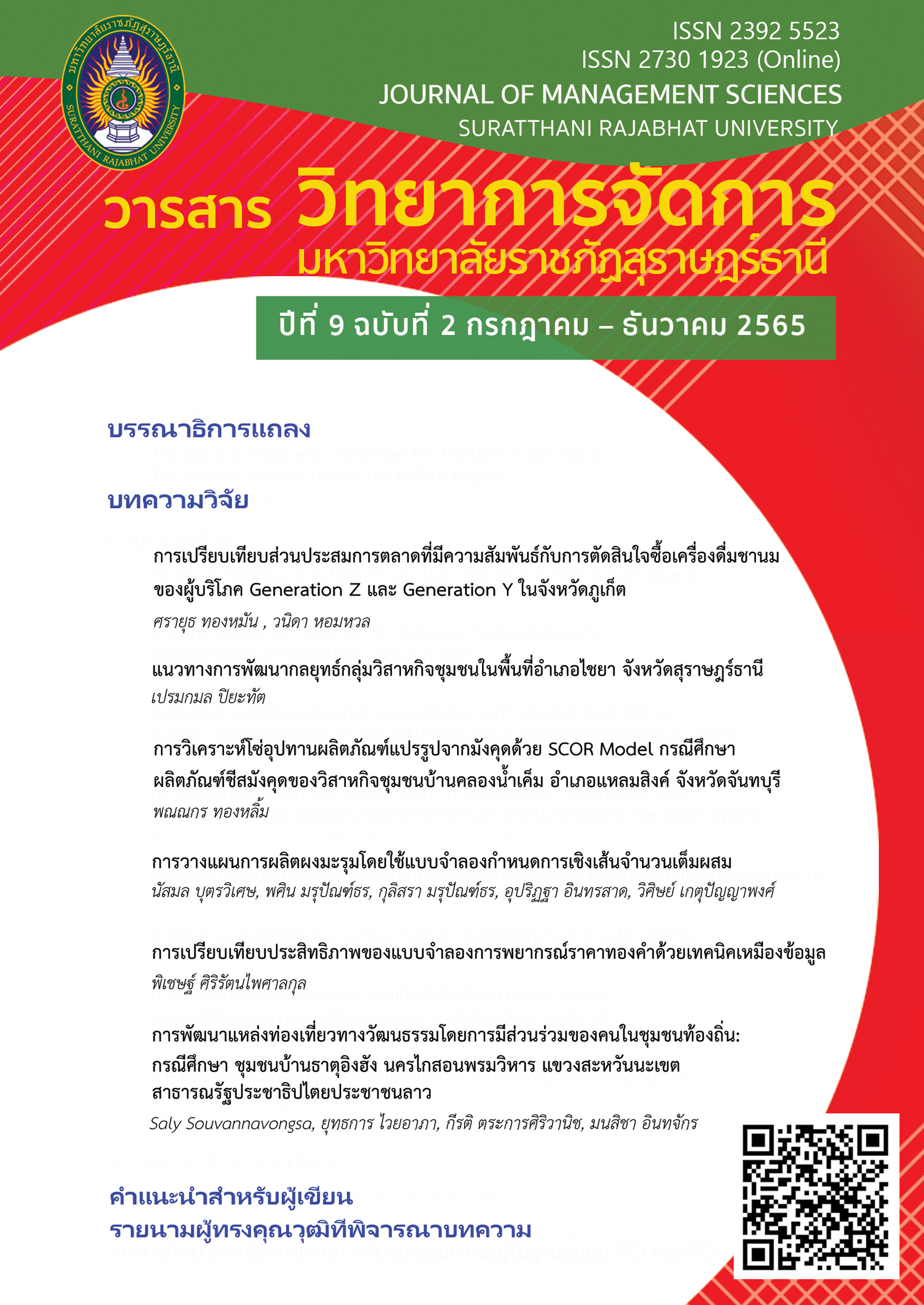Moringa Leaf Powder Production Planning using Mixed-Integer Linear Programming
Main Article Content
Abstract
Hydrated and granulated Moringa oleifera leaf are commercial productions in Thai global markets. In this work, we proposed mixed-integer linear programming for managing the production of Moringa oleifera leaf powder. The models can generate the production plane to minimize production costs and serve all demands from customers. The models were solved by branch and bound algorithm coded in R language with twelve weeks of simulation. The researcher simulated two cases of the situation focusing on inventory cost management. The first case is a low inventory cost that represents Moringa oleifera leaf powder production in Rajamangala University of Technology Suvarnabhumi, Ayutthaya campus. The second is a high inventory cost that mimics middle or large business management. The results showed that planning using the models reduced the overall production cost by 7.06% compared to unplanned production for the low investor cost and 14.30% for the high investor cost. However, the conditions of the model must be satisfied before making a decision. Large-sized and middle-sized businesses should employ the model for managing production processes because their processing and costs are more complicated than the small-sized business.
Article Details

This work is licensed under a Creative Commons Attribution-NonCommercial-NoDerivatives 4.0 International License.
References
Ahumada, O. & Villalobos, J.R. (2009). Application of Planning Models in the Agri-Food Supply Chain: A Review. European Journal of Operational Research, 196, 1-20.
Bernhard, K. O. R. T. E. & Vygen, J. E. N. S. (2008). Combinatorial optimization: Theory and algorithms. Springer Science & Business Media.
Boopathi, N. M., Raveendran, M., & Kole, C. (2021). Moringa and Its Genome: Future Prospects. In The Moringa Genome (pp. 181-185). Springer.
Cachon, G. P. (2004). The allocation of inventory risk in a supply chain: Push, pull, and advance-purchase discount contracts. Management Science, 50(2), 222-238.
Ding, J., Lu, Q., & Chu, X. (2015). The effect of stockout cause and brand equity on consumer preference in online retailing. In Industrial Engineering, Management Science and Applications 2015 (pp. 599-608). Springer, Berlin, Heidelberg.
Fitzsimons, G. J. (2000). Consumer response to stockouts. Journal of consumer research, 27(2), 249-266.
Gonzalez, Y. S., & Van Der Maden, E. C. L. J. (2015). Opportunities for development of the Moringa sector in Bangladesh: Desk-based review of the Moringa value chains in developing countries and end-markets in Europe (No. 15-102). Centre for Development Innovation, Wageningen UR. Centre for Development Innovation, Wageningen UR.
Ketpanyapong, W. & Marupanthorn, K. (2021). Commercial Innovative of Moringa oleifera leaf extract as feed additive in pigs. Research Report, Rajamangala University of Technology Suvarnabhumi.
Korte, B. H., Vygen, J., Korte, B., & Vygen, J. (2011). Combinatorial optimization (Vol. 1). Berlin: Springer.
Kronthaler, F., & Zöllner, S. (2021). Data Analysis with RStudio. Springer: Berlin/Heidelberg, Germany.
Lakhdar, K. & Papageorgiou, L.G. (2008). An iterative mixed integer optimisation approach for medium term planning of biopharmaceutical manufacture under uncertainty, Chemical Engineering Research and Design, 86(3), 259-267.
Lakhdar, K., Zhou, Y., Savery, J., Titchener Hooker, N.J. & Papageorgiou, L.G. (2005), Medium term planning of biopharmaceutical manufacture using mathematical programming, Biotechnology Progress, 21(5), 1478-1489.
Liu, H., Zhang, J., Zhou, C., & Ru, Y. (2018). Optimal purchase and inventory retrieval policies for perishable seasonal agricultural products. Omega, 79, 133-145.
Marupanthorn, K. (2018). Efficiency of Moringa Oleifera Leaves Extract on Osteogenic Differentiation of Porcine Bone Marrow Derived Mesenchymal Stem Cells using Response Surface Methodology. Khon Kaen Agriculture Journal, 2(46), 227 – 236.
Mollel, M. H., Mujuru, M., Mjimba, V., Darangwa, N., & Nyanzi, R. (2021). Moringa oleifira noise: Science or quackery and the way forward. African Journal of Science, Technology, Innovation and Development, 13(3), 273-281.
Package ‘lpSolve’. (2021). https://cran.r-project.org/web/packages/lpSolve/lpSolve.pdf
Poosea, B. (2021, August 23). Real estate enters the rental business 'Factory-Warehouse' a new treasure!!. Bangkokbiznews. https://www.bangkokbiznews.com/business/956075
Pourmohammad-Zia, N. (2021). A review of the research developments on inventory management of growing items. Journal of Supply Chain Management Science, 2(3-4), 71-84.
Prabsattroo T., Wattanathorn J., Iamsaard S., Muchimapura S. & Thukhammee W. (2012). Moringa oleifera leaves extract attenuates male sexual dysfunction. American Journal of Neuroscience, 3, 17–24.
Prabsattroo T., Wattanathorn J., Iamsaard S., Somsap P., Sritragool O., Thukhummee W. & Muchimapura S. (2015). Moringa oleifera extract enhances sexual performance in stressed rats. Journal of Zheijang University Science B, 16, 179–190.
Rajagopalan, S. (2002). Make to order or make to stock: model and application. Management Science, 48(2), 241-256.
Rajendran, T. (2017). Economic Analysis of Moringa in Tamil Nadu. International Journal of Trend in Scientific Research and Development, 1(4), 250-253.
Ritvirool, A. (2012). Linear Programming and Integer Programming and Their Applications in Agro-Industry. Bangkok: AK SORN SOPHON COMPANY LIMITED.
Sae-lee, P. & Ritvirool, A. (2014). An integer linear programming model for herbal cosmetic production planning. KMUTT Research and Development Journal. 37(3), 347 – 360.
Srisukh, V. (2009). Moringa Oleifera: Salutary Herb, Medicinal plant newsletter, 26(4).
Vieira, M., Pinto-Varela, T. & Barbosa-Póvoa, A. P. (2019). A model-based decision support framework for the optimisation of production planning in the biopharmaceutical industry. Computers & Industrial Engineering, 129, 354-367.
Zhichkin, K., Nosov, V., Zhichkina, L., Dibrova, Z., & Cherepova, T. (2019). Development of evaluation model effectiveness of modern technologies in crop production. In IOP Conference Series: Earth and Environmental Science (Vol. 315, No. 2, p. 022023). IOP Publishing.


